JUST IN
by Louis Bofferding
JOHN DICKINSON SEATING SUITE
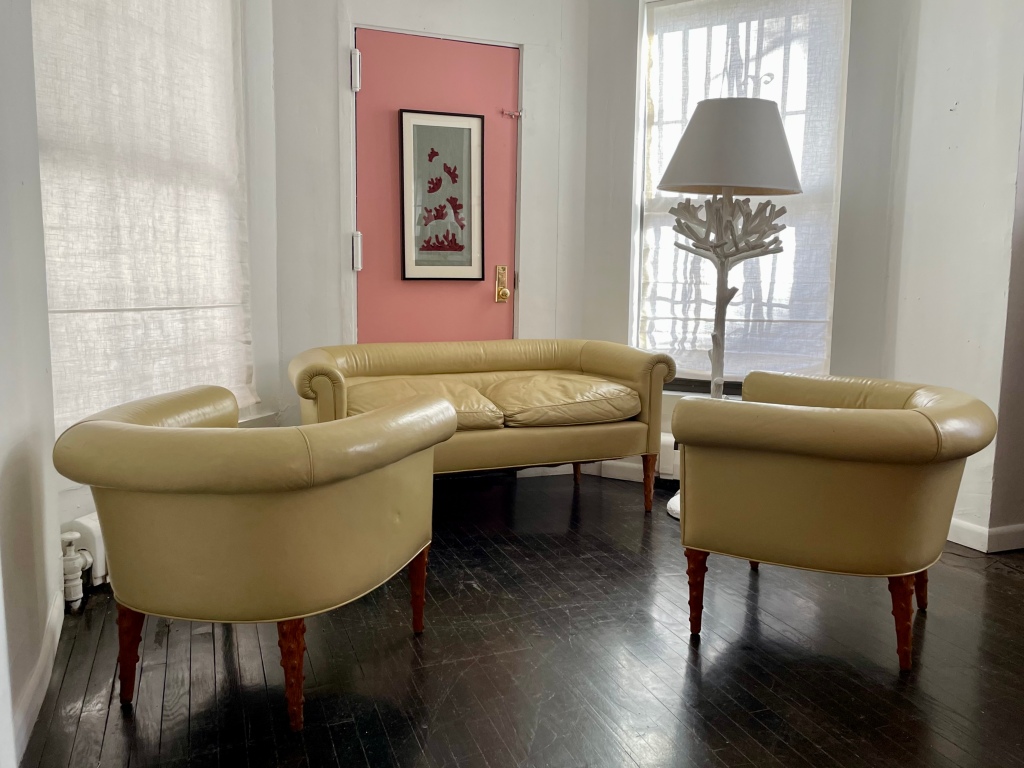


John Dickinson (1920-1982). Unique sofa and pair of armchairs, circa 1970. Carved wood, leather upholstery (each mounted with Dickinson’s fabric label). Sofa H: 26” L: 61” D: 29”; armchairs H: 26” L: D: 33” 29” each. Provenance: John Dickinson, San Francisco; Carlene Safdie. $50,000
John Dickinson designed this low-slung sofa and matching pair of armchairs for his own home, an 1893 San Francisco firehouse that miraculously survived the 1906 earthquake and fire. Their legs were hand-carved to resemble tree branches, and they retain their original butterscotch-colored-leather upholstery, specked with tiny claw marks from Dickinson’s cats (his favorite Bertie, short for Bertrand Russell, is seen in his arms in the photo). Beneath the cushions, discretely sewn to the frames, are labels bearing the designer’s name, location, and membership in the American Institute of Decorators (the predecessor of the ASID). This clever conceit was inspired by fashion-brand labels (Dickinson wore Saville Row suits, Missoni sweaters, and Brooks Brothers shirts), and heralds the blurring distinction between the design and fashion worlds that we know today.
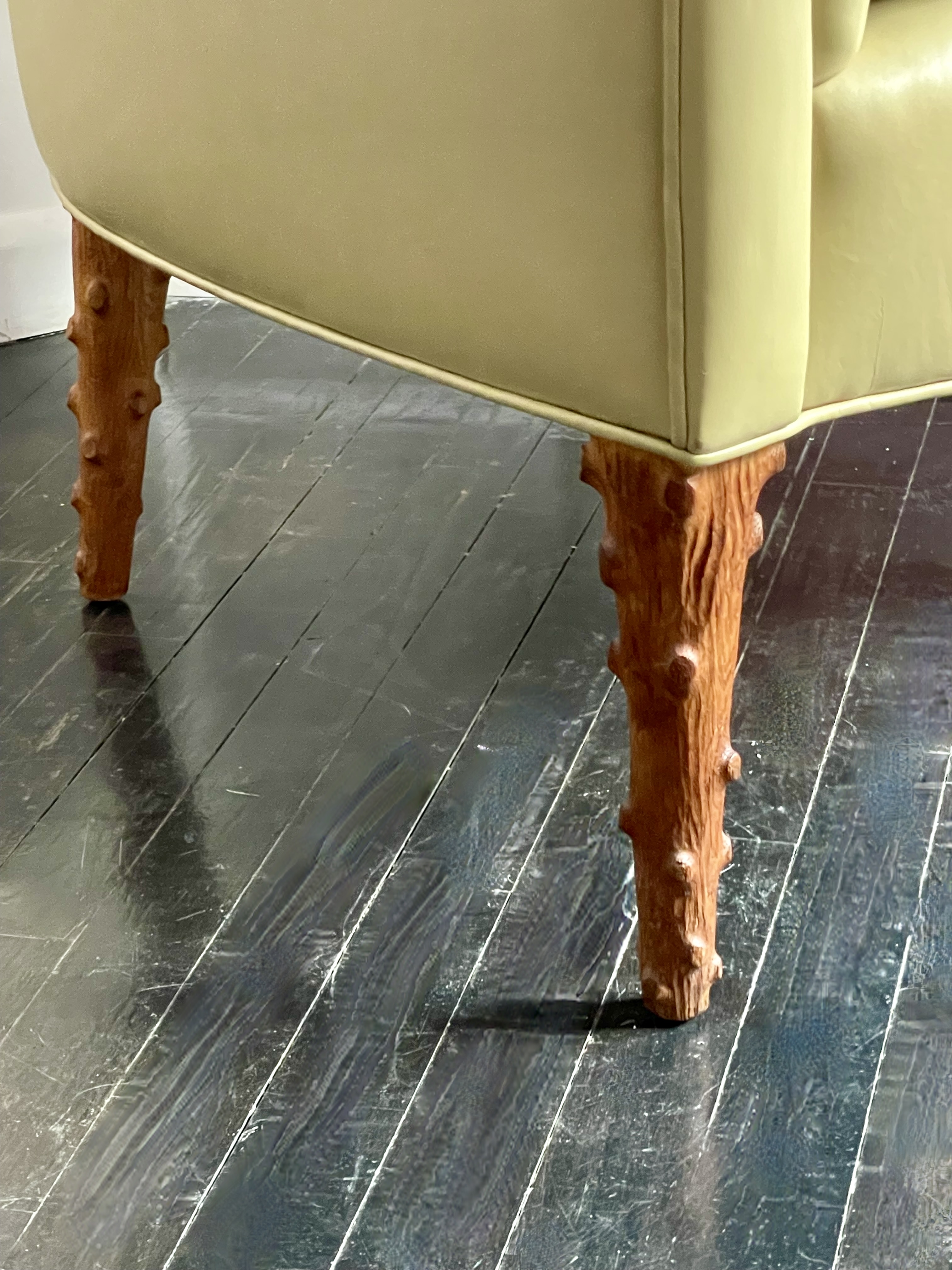


One other nearly identical seating group was made for his friend and client Ralph DuCasse, an abstract painter who created the two minimalist white-on-white canvases that were hung opposite each other in Dickinson’s firehouse, adjacent to our seating group [below right]. His differed only in their brass-capped feet and puce-colored-leather upholstery. Ours were inherited, along with the rest of his estate, by his client, heir, and muse Carlene Safdie, from whom we acquired them.


Dickinson’s beautifully rendered drawing for both [below], as well as all of his working drawings, were donated to the San Francisco Museum of Modern Art by Ms Safdie. As they make clear, when designing he took inspiration from diverse art-historical styles and cultures, including the ancient world, 18th-century France, Art, Deco, and African art. In so doing he faced head on the post-modernist dilemma that, as he said in a 1978 interview, “somehow, somewhere, it’s all been done before.” And yet, he continued, with “so many ways to say the same familiar things, originality is paramount.” Our suite is a synthesis of a tree-branch motif as old as time itself, and the 1930s Streamline Moderne. That he was able to combine such disparate sources so seamlessly and artfully is just one reason we consider Dickinson to be America’s preeminent designer of his generation.
JOHN DICKINSON UNIQUE STANDING LAMP


John Dickinson (1920-1982). Standing lamp from a unique pair, circa 1970. Plaster over metal armature. H: 64” Dia: 19″ (with shade “). Provenance: John Dickinson, San Francisco; Carlene Safdie. $25,000
John Dickinson designed this standing lamp in the form of a tree, and modelled the plaster to imitate twigs, branches, trunk, and roots. Witty and idiosyncratic, only two of these lamps were made, both for the San Francisco firehouse he called home. They anchored either end of a long corridor lined with closet doors, which were encrusted with millwork and mirrors, mimicking the Victorian gingerbread townhouse facades that he saw from the firehouse windows.

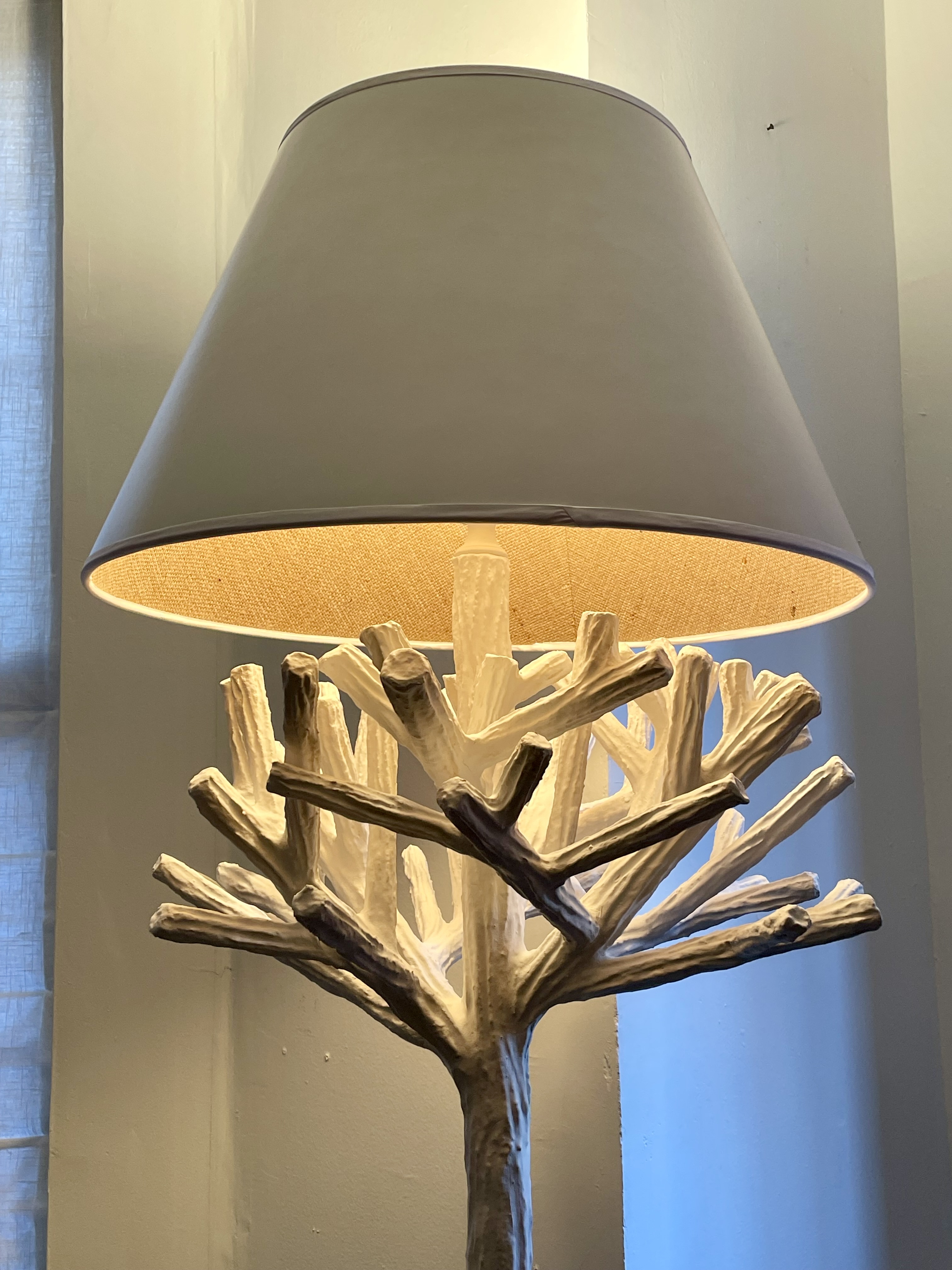
Dickinson took into account how this lamp would look when switched on in designing it. If this sounds like par for the course, it isn’t. Most designers devise a more or less sculptural base, and apply surface decoration, or leave it undecorated to emphasize the material. The result looks pretty much the same when on as off. This lamp, however, is transformed when on, with branches that catch and fracture light to form a spiky halo. We had a lampshade made to replicates the original that had long since disappeared. It’s lined with the tan hopsacking Dickinson often used for the purpose, in addition to colored felt, and pink Oxford cloth, which matched his pink Brooks Brothers shirts. On occasion he even had shades made from galvanized steel.


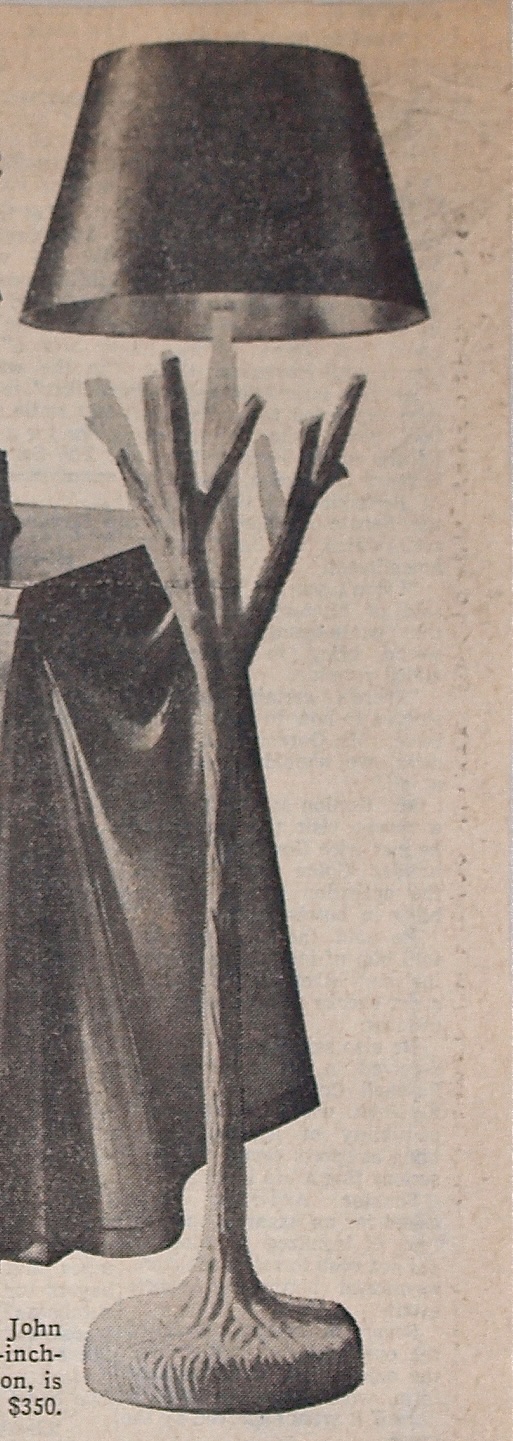
The branch motif was a favorite of Dickinson’s. It’s seen in the legs of our sofa and pair of armchairs, as well as a number of his designs for lighting fixtures. One example is a plaster table lamp that’s a truncated version of our standing lamp, and another is a standing lamp that’s a skinnier pruned version of our bushier and more substantial one. Our lamp and its mate had plaster applied over a multi-pronged metal frame. The reason for this is that he wanted to use its branches as pegs for hanging clothing. One of the pair is seen put to this use in the photograph of them in situ. And so, if designed to do double duty as a lamp and a “silent valet,” we find it actually does triple duty as a sculpture, pure and simple.
LOUIS-PHILIPPE METAL CABINET

Louis-Philippe period cabinet (chauffe plaque, or plate warmer), circa 1840. Cast iron & sheet metal, painted & gilded, fossilized-marble top. H: 41″ W: 27 1/4″ D: 15″. $8,500
This cabinet is made entirely of metal — except for the fossilized black-marble top. It’s a chauffe-plaque, or plate warmer, designed to keep plates and food from going cold during the course of a meal. That’s why there’s a drawer at the bottom for hot coals, and perforated shelves inside, permitting hot air to circulate within. The two handles on either side are for moving the cabinet hither and yon, depending on where the meal was to be served, since, in early 19th century France, dining was an ambulatory affair (at the time, the English “dining room” was just beginning to gain ground across the Channel). That said, the heavy marble top, well-suited for dishing out food, would have made one think twice about moving it. And so it probably remained stationary in a home or office, with handles that were little more than a design holdover from the more typical brass chauffe-plaques, which were carried from campfire to officer’s tent on military campaigns. This type, however, which is lavishly mounted with Neo-Classical gilt ornaments, is more rare.


GEORGES JACOB SECRETAIRE


Georges Jacob (1739-1814), active 1765-1796. Drop-front secrétaire, 1796 or just before. Solid & veneered mahogany, gold-tooled leather, paint, brass & steel fittings. H: 51″ W: 27 ¼” D: 15 ¾”. Provenance: Richard A. Lee, Ardmore, PA, acquired at Sotheby’s New York. $12,500
The career of Georges Jacob, one of the most celebrated 18th-century French furniture makers, spanned the reigns of Louis XVI, the Directorate, and the Empire of Napoleon. Our secrétaire was created just prior to his retirement in 1796, and is, stylistically speaking, on the cusp of the latter two of the three. It has all the refined delicacy of the former, and, in spite of its small scale, the severe monumentality of the latter.


Jacob kept the ornamentation of this secrétaire to a luxurious minimum. Four gilt-bronze rosettes articulate each corner of the front, and the pair of feet below were carved in the form of animal-paws, and blackened to simulate bronze. Such restraint emphasizes the three large mahogany veneers that surface the front and sides. This timber, imported from the French West Indies, was then rare and expensive. Surprisingly, the carcass beneath is of mahogany too — an indication no expense was spared in its making.
The rosette at the top left of the front pivots to reveal a keyhole. When unlocked, a panel drops to form the working surface, paved with gold-tooled olive-green leather, and to access seven drawers and two open shelves. Press an unobtrusive button on the left side, and the door below the panel swings open, allowing access to a storage drawer and open shelf.


In 1765 Jacob was admitted to the Corporation des Ebénistes-Menuisiers – Guild of Cabinetmakers and Carpenters — that enforced exacting standards of craftsmanship, and required its members to work in one field or the other. Jacob was admitted as a carpenter and came to be celebrated for the many chairs, sofas, and console tables ordered by the French nobility. Following the 1789 Revolution, forcing many of his clients to mount the scaffold, guild restrictions loosened and Jacob began to work as an ébéniste as well. That the guild officials deemed him to be up to both tasks is indicated by the JME stamp on the back of the secrétaire, next to the G. JACOB stamp confirming his authorship. Those three initials stand for Jurand des Menuisiers-Ebénistes, or Jury of Joiners and Cabinetmakers. To ensure that members maintained high standards, they paid their workshops four visits a year, and applied this stamp to finished pieces that made the grade. Those that did not were confiscated. Ours, evidently, passed muster.
18th CENTURY DUTCH COMMODE

Dutch 18th century commode, 1780s. Satinwood with inlays of mahogany, tulipwood, and other woods, brass hardware. H: 32 ½” W: 32 ¼” D:15 ½. $10,000
Holland’s Golden Age was the 17th century. Then, this small but industrious and beleaguered nation was a political and artistic player. Holland’s halcyon days, however, date to the 18th century when it continued to flourish financially, and was at relative peace with its neighbors. By this time the boisterous Baroque had given way to the graceful Rococo, and the subsequent Neo-Classical style. Our small but exquisite commode embodies the latter. It’s entirely veneered with satinwood, mahogany, and a variety of rare woods. Most notable, however, are the seven realistic inlays of conch shells set in beaded boarders. The largest is on the top, and the others – all different – appear in symmetrical pairs on the sides, doors, and drawer. In contrast, architectonic alternating light-and-dark square inlays are inlaid around the top and appear to support it, mimicking the metopes and triglyphs of a classical building’s entablature.


The commode’s delicacy of form, high-contrast wood inlays, and chamfered corners, are typically Dutch. But those high contrasts, and the inlaid shell motif, suggest the influence of the fashionable contemporary London cabinetmaker Thomas Sheraton. At the time his work was well known throughout northern Europe, due to the wide distribution of his 1786 pattern book The Cabinet Maker and Upholsters Guide. The anonymous craftsman who fashioned our commode, however, made it very much his own with an enchantingly idiosyncratic proliferation of shells, beaded enframements, and staccato-like inlay beneath the top rail.


SMALL 18th CENTURY CONSOLE

Small Italian 18th century console or bracket, 1770s. Carved wood, gilded in yellow- and white-gold leaf, painted top. H: 16 ½” W: 19″ D: 9.” $6,000
This large wall bracket, perhaps intended to support a large porcelain, would serve equally well as a small console table. While somewhat indebted to the French in its design, the bold cartouche, the exuberant carving of the flowers, and the piercings that expose glimpses of the wall behind, suggest it was made in Italy, possibly Turin or Genoa, where the French influence was strong. It’s unusual in having been gilded in both white- and yellow-gold leaf — white-gold for the small petaled flowers and leaves, yellow-gold for the full-blown roses and cartouche, which may once have featured the owner’s initials or coat of arms.
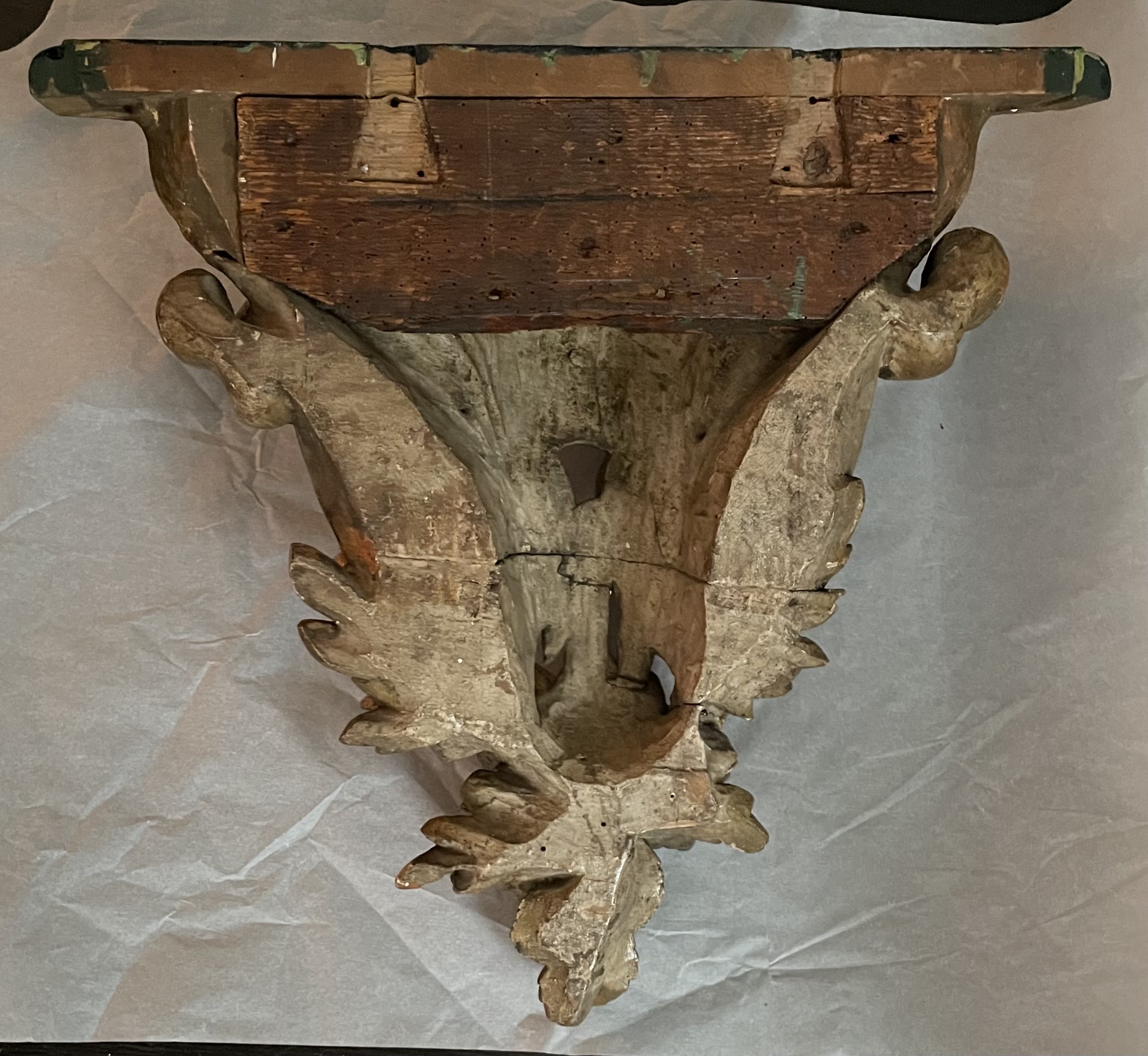
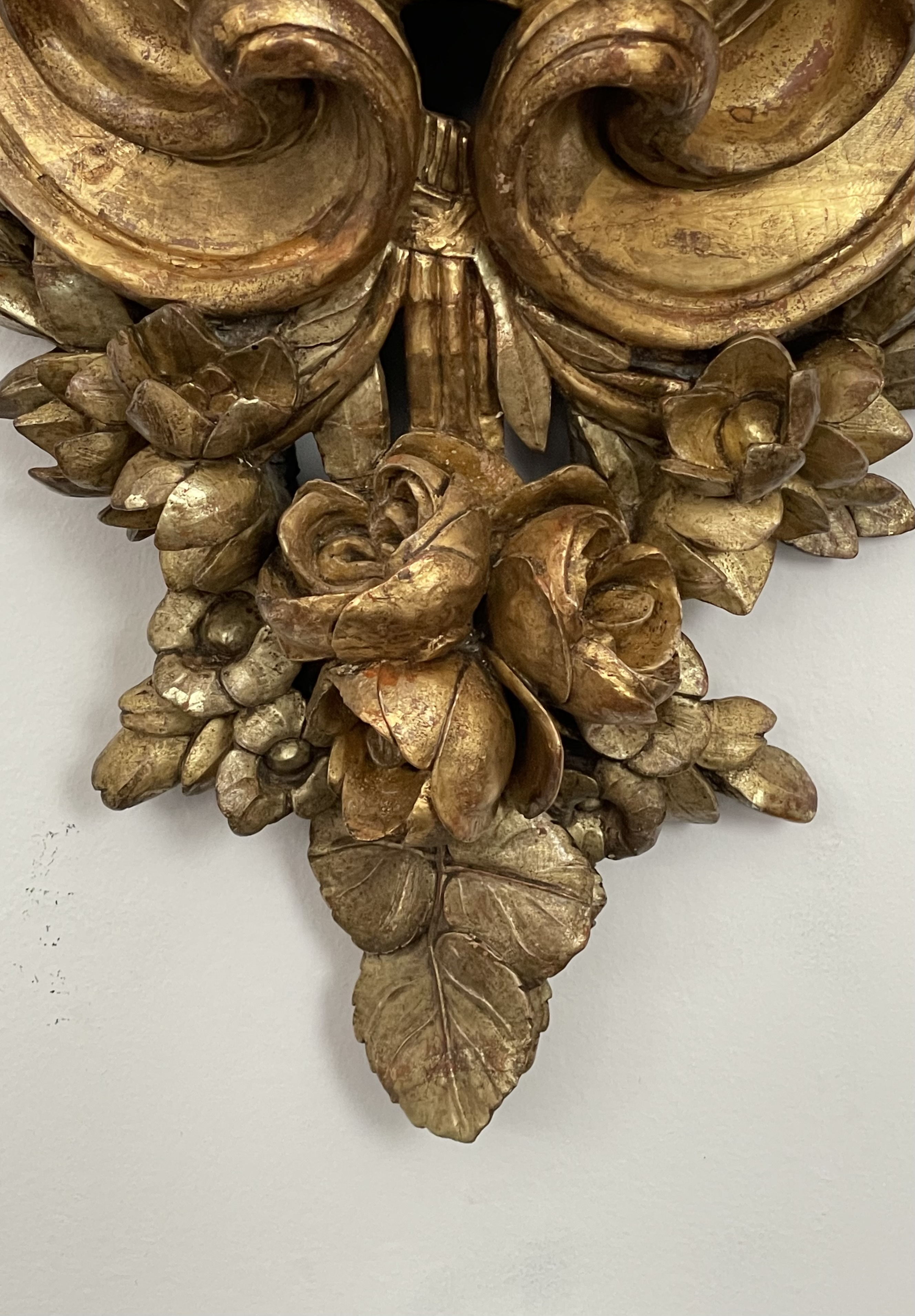
BILLY BALDWIN SLIPPER CHAIR

Billy Baldwin (1903-1983) slipper chair, circa 1970. Green leather upholstery, wood frame. H: 30 ½” W: 19” D: 25.” $5,000
“Small women and football linebackers find it equally comfortable,” Billy Baldwin wrote about his slipper chair design in his 1972 book Billy Baldwin Decorates. And if a linebacker has yet to publicly attest to Baldwin’s claim, it does suit my six-foot frame, just as it did the diminutive ones of Truman Capote’s swans. After all, Babe Paley was a client, as Lee Radziwill was too, of a sort, since, much to his chagrin, he never saw the color of her money, and she picked his brain relentlessly when secretly preparing for her brief stint as a decorator.
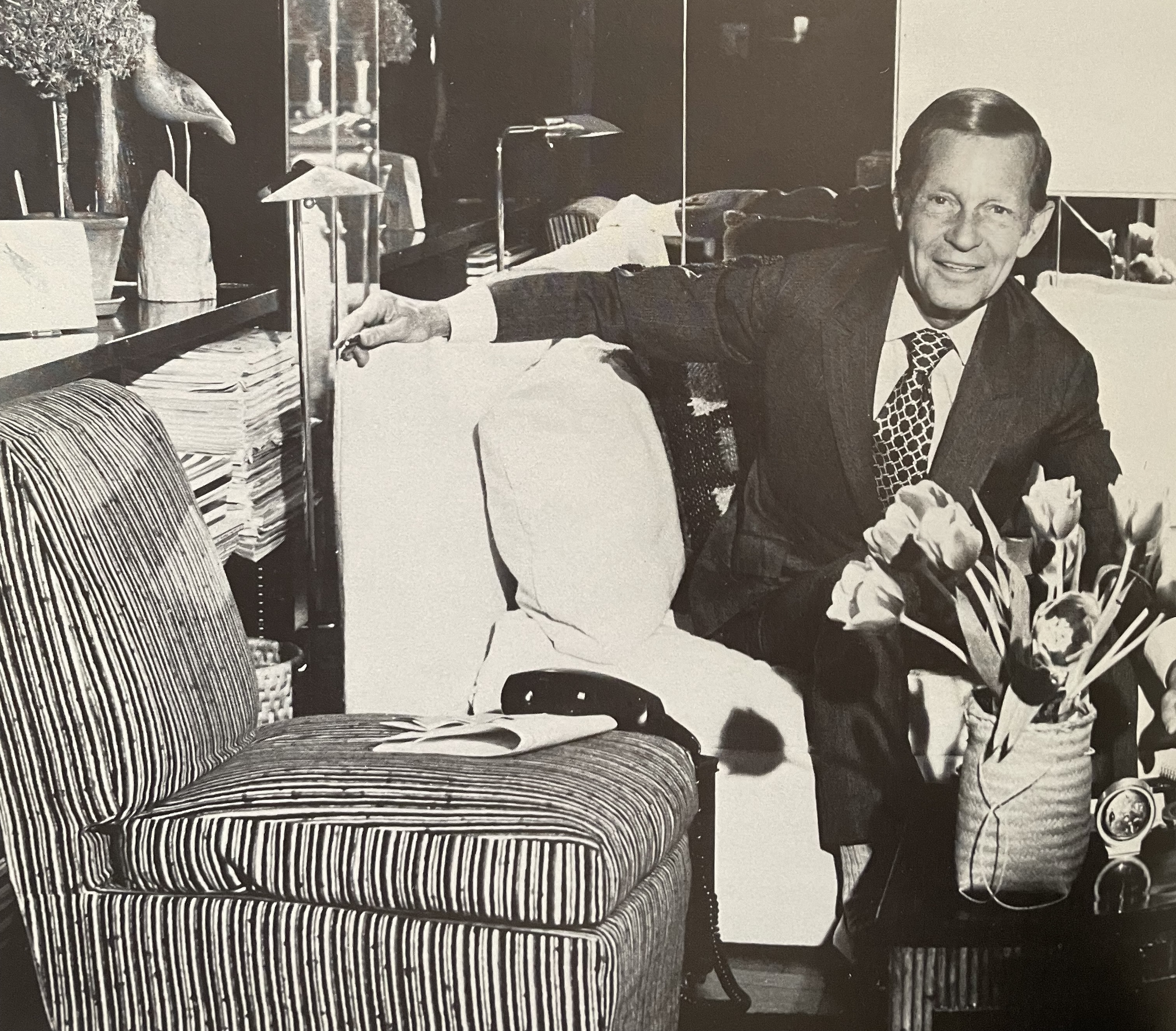

The comfortable all-upholstered slipper chair was hardly Baldwin’s invention. It dates to the early 18th-century. And his take on it bears more than a passing resemblance to the over-scaled and box-pleated ones that were a standard feature in the rooms of his mentor and employer Ruby Ross Wood. Nevertheless, he pared down and resculpted that chair until he made it his own – to the point it’s identified with him, just as the Parsons table is with Jean-Michel Frank. Baldwin’s chair launched a thousand imitations by those who sought to cash in on his flawless design without paying him royalties. So one might well ask if this leather-upholstered slipper chair is an original. Unfortunately we don’t know the provenance, but it does conform to the very inch in dimensions, and upholstery details, to a pair we had that were supplied by Baldwin. Besides, magnolia-leaf green was his favorite color (he lifted it from Elsie de Wolfe’s 1940s Hollywood years), which is why he used it on the walls of his first Manhattan apartment in Amster Yard, as well as those of the Park Avenue bedroom he decorated for S. I. Newhouse, Jr., which just happened to be graced with a black-leather slipper chair, placed hard by the Kenneth Noland.
1930s ALABASTER LAMP


Alabaster lamp made by the Cooperativa Artieri Alabastro, Volterra, 1930s. H:15″ Dia: 9 1/2″. $8,000
This 1930s urn-form lamp, hewn from a solid block of alabaster, is masterfully and realistically carved with grapes, leaves, tendrils, and roots. The stone’s translucency and openwork carving create a spectacular effect when illuminated. The lamp was sold through the Cooperativa Artieri Alabastro, or the Alabaster Craftsmen’s Cooperative, in Volterra, a picturesque Tuscan town celebrated for its alabaster quarries. The Cooperative was established in 1895 by local carvers of alabaster vases, lamps, decorative objects, and sculptures. It kept a percentage of the profits to maintain a salesroom and an archive, and grant scholarships to promising young designers and sculptors to the local art academy. In the 1930s, works by the Cooperative’s members gained the admiration of modernist architect-designer Gio Ponti, who, in 1928, established Domus, the monthly design magazine that’s still being published today. And there, in the July 1937 issue, he published an article on their work, illustrating a lamp in the form of a cornucopia, which we also happen have in our inventory as a pair.


The following July Domus published another article on their work, and put a pair of tabletop objects by Umberto Zimelli on the cover. Ponti’s continued interest in the firm was thanks to the appointment of Umberto Borgna, a graduate of the Florence art academy, as the Cooperative’s artistic director. Previously, it favored white alabaster, occasionally made even whiter by subjecting it to intense heat. But under Borgna it promoted the brownish alabaster that had irregular ash inclusions, which gave it character, and a moody mystery when backlit. Borgna also solicited modern designs from architects, artists and designers, among them Ponti himself, Franco Albini, and Umberto Zimelli, who submitted designs for whimsical table-top objects. And so, as the Great Depression raged on, the Cooperative entered its golden age, exhibiting at design fairs, and sending work off to prominent retailers, ranging from La Rinascente in Milan to Macy’s and Marshall Fields in the States.
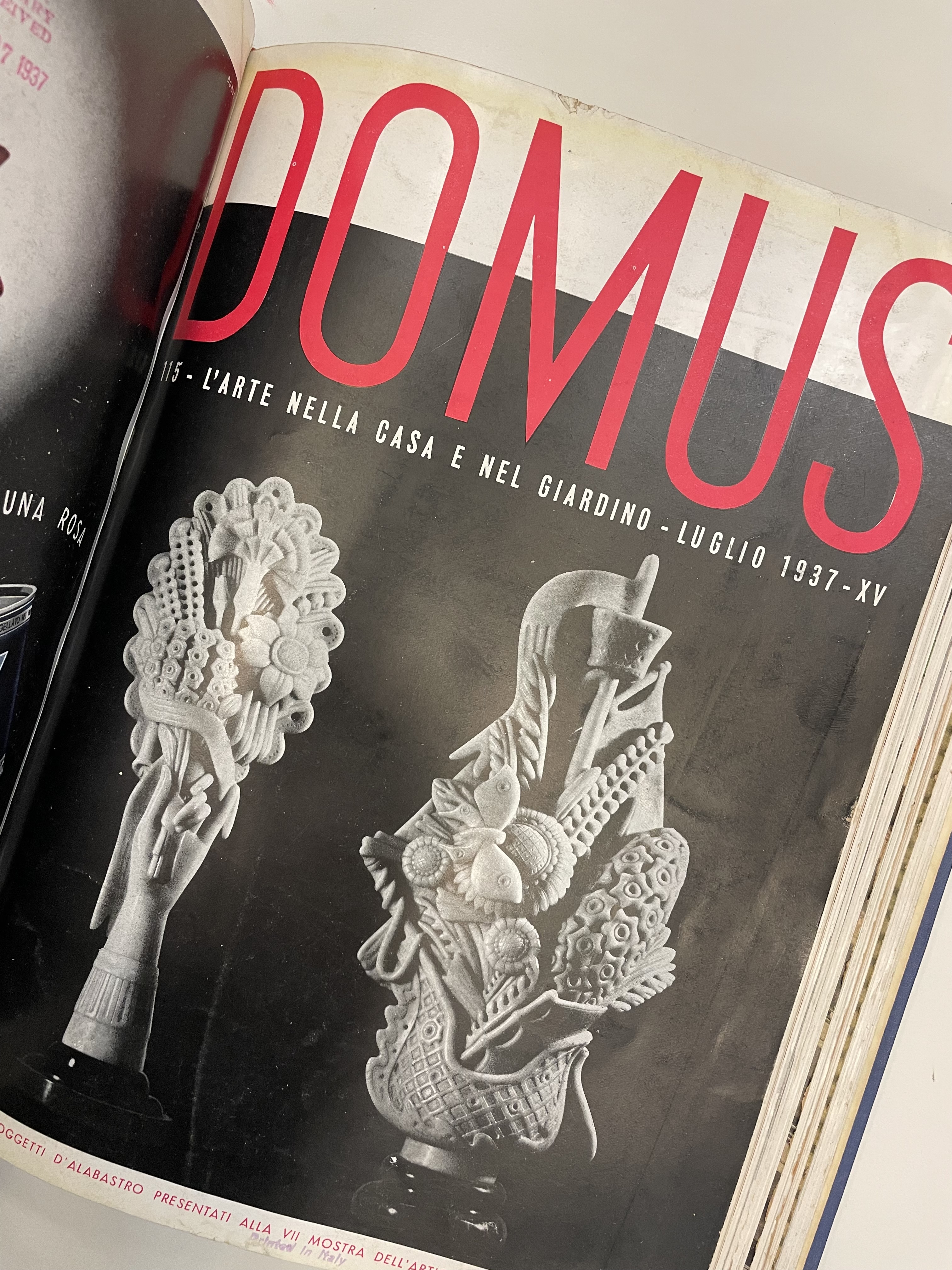

LOUIS-PHILIPPE LAMP

Louis-Philippe carcel lamp by Gotten of Paris (marked “Place des Victoires No 1 / Gotten / Inventeur Brevete”), 1840s. Bronze, gilding, acid-etched cast glass with brass trim. H: 30 ½” Dia: 7.” Provenance: Richard A. Lee, Ardmore, PA. $4,000
According to an attached metal plate, this imposing gilt-bronze lamp was made in Paris by Gotton, Inventeur Brevete (inventor and patent holder), and sold from his retail premises at 1 Place des Victoires. Gotton was Jean-Cristophe Gotten, who received a patent in 1821, which was renewed in 1825, for a type of oil-burning lamp with a reservoir at the base, and a pump to carry it to the top, where it emitted light when ignited. Our lamp has since been wired for electricity, but, fortunately, when that happened the original brass-trimmed glass globe wasn’t replaced by a lampshade. Also of note are the lamp’s finely chiseled gilt-bronze Neo-Classical decorations. On the reeded column shaft they consist of a foliate capital and base, and, on the lamp’s base, of flower wreathes overlaying crossed thyrsi (the pine-cone-topped staffs of Bacchus), alternating with pairs of griffons.
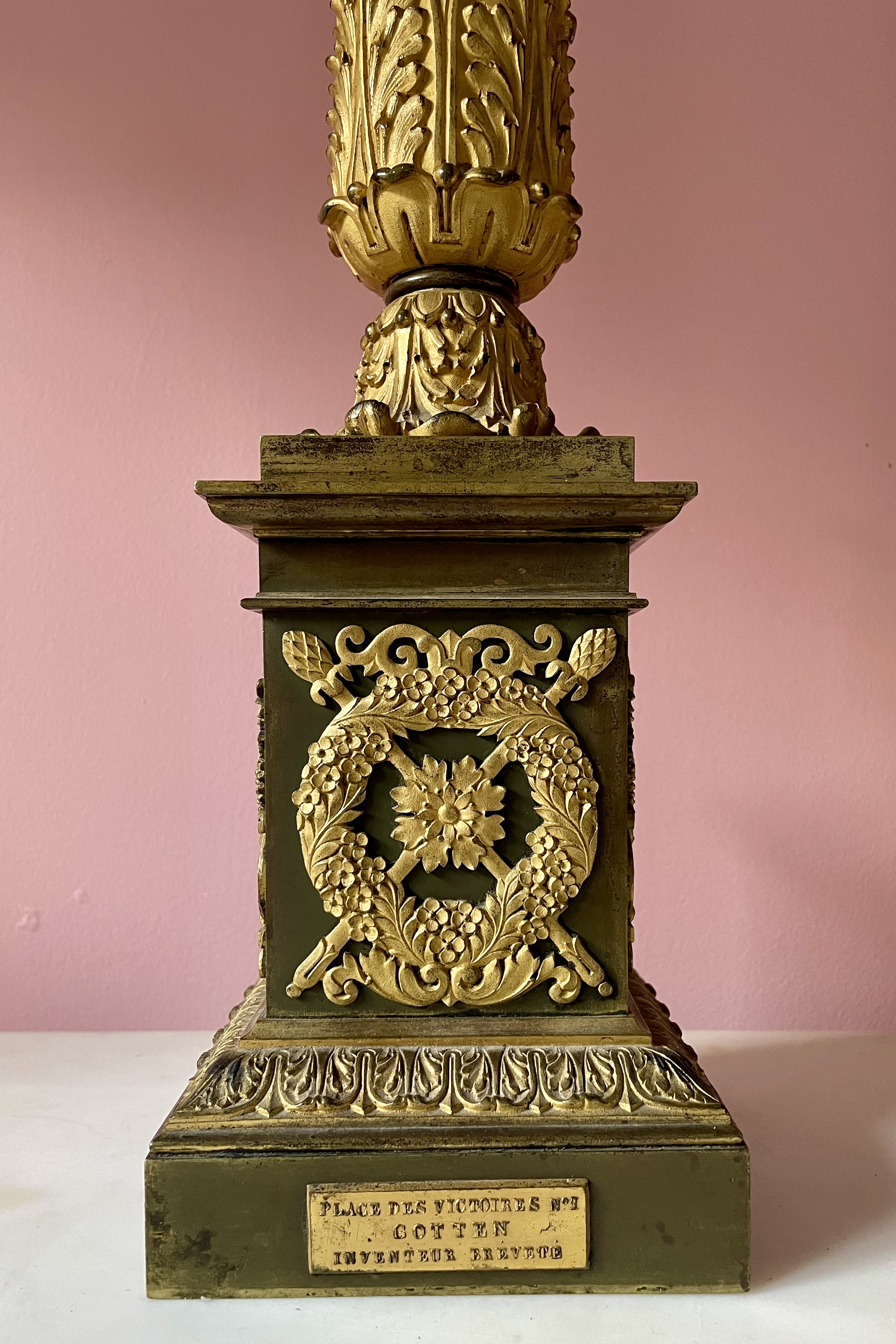


ASIAN TABLETOP MIRROR FOR THE WESTERN MARKET


Asian, probably Japanese, table-top mirror for the export market, circa 1900, indistinctly signed by the maker. Lacquered wood, gold decorations, mother-of-pearl inlay. H: 25 ¼” W: 11 ½” D: 9″.
Provenance: Richard A. Lee, Ardmore PA. $ 3,750
This elegant table-top mirror was probably made in Japan around 1900 for the Western market. By that time, Asian lacquerwares with mother-of-pearl inlays had been prized for centuries, to the profit of both Eastern craftsmen and Western retailers. This mirror represents an aesthetic amalgam of the two continents. The lacquer work and the mother-of-pearl-scaled dragon is decidedly Asian, whereas the scalloped top and elongated shape reflect the Queen Anne and William-and-Mary styles that prevailed in England and the American colonies around 1700. Those styles were being revived in England and the States just before 1900, around the same time that japonisme was in vogue. While the mirror’s Western form, and indistinct maker’s mark on the hinged back support, make it difficult to pinpoint a Chinese or a Japanese origin, as noted, we’re betting on Japan.


VAN DAY TRUEX DRAWING

Van Day Truex (American,1904-1979). Forio, Ischia, circa 1950. Watercolor wash on paper, original wood frame. 15 ¾” x 14 ¼” sight; 19 ¾” x 18″ framed. Provenance: Natalia Platonova Boleslavski; by descent. $6,500.
Smart, talented, charming, and handsome, Van Day Truex was destined for a brilliant career. Born in rural Kansas in 1904, he left to attend what would become the Parsons School of Design in New York. He became the protégé of its founder Frank Alva Parsons, and then, when studying at the school’s Paris branch, its director William Odom, known as “Mr. Taste.” On graduating in 1926, Truex was appointed director of the Paris branch when Odom was summoned back to New York to assume the duties of an ailing Parsons. In gay Paree, Truex became a fixture in the creative and social firmament, befriending the American ex-patriot Elsie de Wolfe, Jean-Michel Frank, Elsa Schiaparelli, Horst, the Cole Porters, and Charles and Marie-Laure de Noailles, among others. The 1939 outbreak of war found Truex summering on Capri as a houseguest of Mona Williams (later Mona von Bismarck), prompting an escape to New York from Naples aboard the Rex. Shortly after disembarking, Odom, who had inherited the school on Parsons’ demise, and was now ailing himself, turned its management over to Truex, where he went on to teach, inspire, and dazzle the student body until being sidelined in a 1954 academic coup. Truex took it on the chin, and one year later was appointed the artistic director of Tiffany & Company. In that capacity, over the course of over two decades, he divided his time between New York and Europe, designing and commissioning products that would put the venerable firm back on the map, and prompt Truman Capote to make it the nexus of Holly Golightly’s fantasies in Breakfast at Tiffany’s.


Other recent arrivals can be seen at FEATURED INVENTORY
From the 1930s until his 1979 death, Truex took considerable pleasure from his unofficial parallel career as a painter of grisaille watercolors. In the 1930s he exhibited them twice at the Wildenstein Gallery, and in the 1940s at Knoedler, prompting an Art News critic to opine, “One would like for the museums of this country to get to know Truex’s work, and see him take his place as a serious painter in the annals of American art where he belongs.” The National Gallery in Washington did, in fact, buy two drawings, and in 1955 the California Palace of the Legion of Honor gave him a one-man show. And, during that one-year hiatus between Parsons and Tiffany’s, he took a painting residency at the American Academy in Rome.


As a designer Truex approached the cutting edge, but as an artist he pursued the beautiful — a quality that the art world came to regard as a bit old fashioned as the 20th century progressed. Not that he was oblivious to the latest art trends, specifically Abstract Expressionism. At first glance our representational drawing of an Italian village appears to be an abstract composition with edge-to-edge marks and blobs of wash. This suggests an awareness of Jackson Pollock’s trailblazing work done around the same time, characterized by energetic gestures, drips, and webs of paint that create the “all-over” image, thus emphasizing the two-dimensionality of the picture plane.
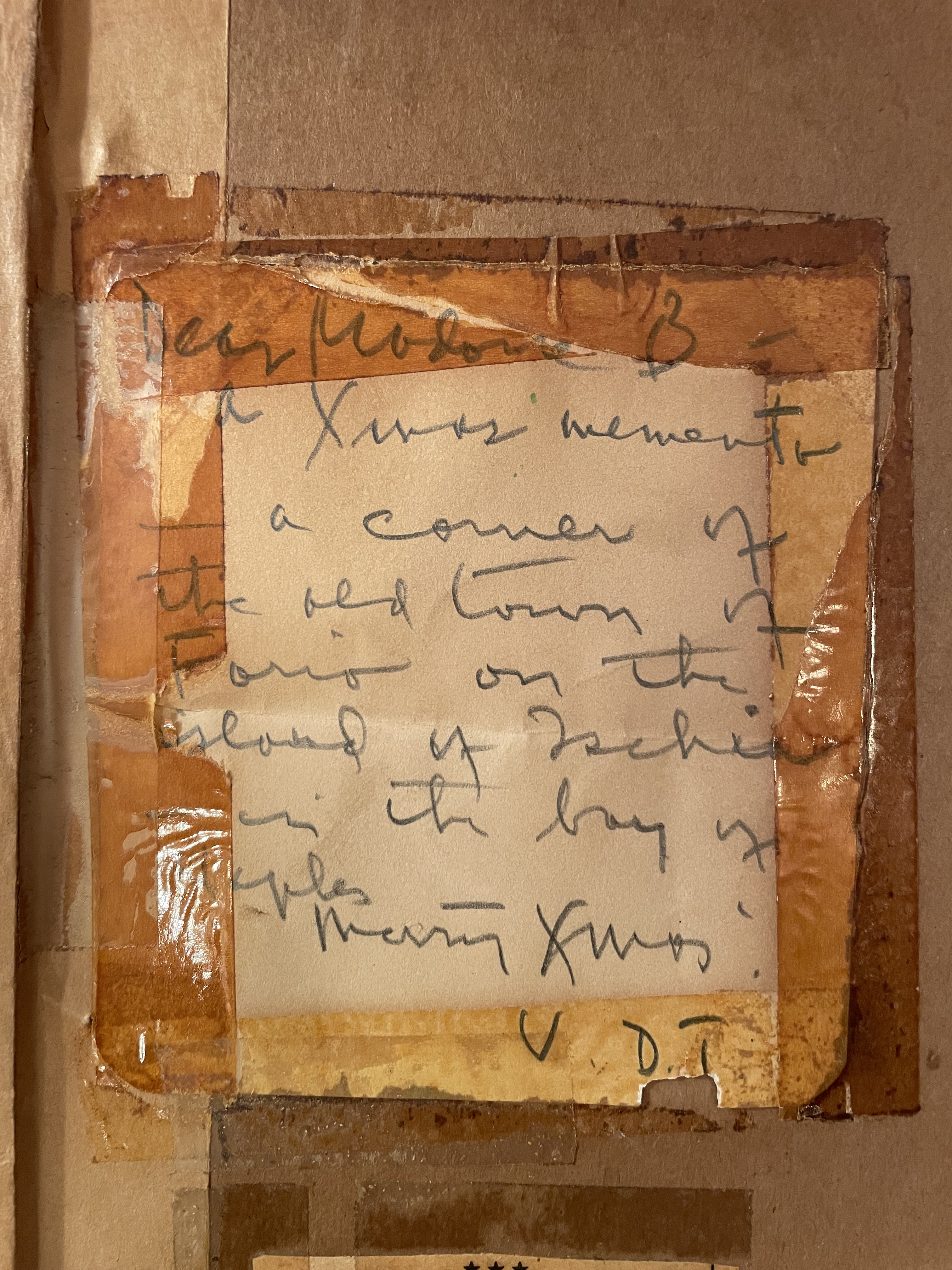

An inscription on our drawing’s verso reads as follows: “Madame B – a Xmas memento – a corner of the old town of Forio on the island of Ischia – in the Bay of Naples – Merry Xmas! V. D. T.” Truex frequently gave his works to friends, and this particular friend was Natasha Platonova Boleslavski, a white Russian émigré who was divorced from the Hollywood director Richard Boleslavski. She lived in Manhattan, and often invited Truex to stay at her country house in Bridgewater, Connecticut. As for the scene, on close inspection, it’s seen to depict the picturesque seaside town in a ruinous state. It may record the town’s appearance in the years that followed a 1943 Allied bombing, or after one of the many earthquakes that still rock the island. Either way, unless it commemorates an Ischian holiday he took with Mrs. Boleslavski, which is possible, or an inside joke they shared, it’s a decidedly odd subject for a Christmas present.
Other recent arrivals can be seen at FEATURED INVENTORY
R. LOUIS BOFFERDING FINE & DECORATIVE ART
BY APPOINTMENT
141 EAST 62ND STREET NEW YORK NY 10065
(917)572-5041
